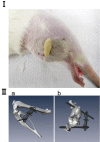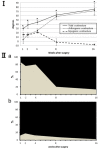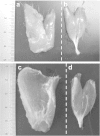Contributions of biarticular myogenic components to the limitation of the range of motion after immobilization of rat knee joint
- PMID: 25001065
- PMCID: PMC4132191
- DOI: 10.1186/1471-2474-15-224
Contributions of biarticular myogenic components to the limitation of the range of motion after immobilization of rat knee joint
Abstract
Background: Muscle atrophy caused by immobilization in the shortened position is characterized by a decrease in the size or cross-sectional area (CSA) of myofibers and decreased muscle length. Few studies have addressed the relationship between limitation of the range of motion (ROM) and the changes in CSA specifically in biarticular muscles after atrophy because of immobilization. We aimed to determine the contribution of 2 distinct muscle groups, the biarticular muscles of the post thigh (PT) and those of the post leg (PL), to the limitation of ROM as well as changes in the myofiber CSAs after joint immobilization surgery.
Methods: Male Wistar rats (n = 40) were randomly divided into experimental and control groups. In the experimental group, the left knee was surgically immobilized by external fixation for 1, 2, 4, 8, or 16 weeks (n = 5 each) and sham surgery was performed on the right knee. The rats in the control groups (n = 3 per time point) did not undergo surgery. After the indicated immobilization periods, myotomy of the PT or PL biarticular muscles was performed and the ROM was measured. The hamstrings and gastrocnemius muscles from the animals operated for 1 or 16 weeks were subjected to morphological analysis.
Results: In immobilized knees, the relative contribution of the PT biarticular myogenic components to the total restriction reached 80% throughout the first 4 weeks and decreased thereafter. The relative contribution of the PL biarticular myogenic components remained <20% throughout the immobilization period. The ratio of the myofiber CSA of the immobilized to that of the sham-operated knees was significantly lower at 16 weeks after surgery than at 1 week after surgery only in the hamstrings.
Conclusions: The relative contribution of the PT and PL components to myogenic contracture did not significantly change during the experimental period. However, the ratio of hamstrings CSAs to the sham side was larger than the ratio of medial gastrocnemius CSAs to the sham side after complete atrophy because of immobilization.
Figures







Similar articles
-
Cyclooxygenase-2 inhibitor celecoxib attenuates joint contracture following immobilization in rat knees.BMC Musculoskelet Disord. 2016 Oct 24;17(1):446. doi: 10.1186/s12891-016-1303-5. BMC Musculoskelet Disord. 2016. PMID: 27776498 Free PMC article.
-
Morphological and biomechanical adaptations of skeletal muscle in the recovery phase after immobilization in a rat.Clin Biomech (Bristol). 2020 May;75:104992. doi: 10.1016/j.clinbiomech.2020.104992. Epub 2020 Mar 27. Clin Biomech (Bristol). 2020. PMID: 32380349
-
Intra-articular collagenase injection increases range of motion in a rat knee flexion contracture model.Drug Des Devel Ther. 2017 Dec 21;12:15-24. doi: 10.2147/DDDT.S144602. eCollection 2018. Drug Des Devel Ther. 2017. PMID: 29317799 Free PMC article.
-
Effects of therapeutic ultrasound on joint mobility and collagen fibril arrangement in the endomysium of immobilized rat soleus muscle.Ultrasound Med Biol. 2009 Feb;35(2):237-44. doi: 10.1016/j.ultrasmedbio.2008.09.001. Epub 2008 Nov 17. Ultrasound Med Biol. 2009. PMID: 19010586
-
Muscle contractile exercise through a belt electrode device prevents myofiber atrophy, muscle contracture, and muscular pain in immobilized rat gastrocnemius muscle.PLoS One. 2022 Sep 23;17(9):e0275175. doi: 10.1371/journal.pone.0275175. eCollection 2022. PLoS One. 2022. PMID: 36149919 Free PMC article.
Cited by
-
Intra-articular injection of mitomycin C prevents progression of immobilization-induced arthrogenic contracture in the remobilized rat knee.Physiol Res. 2020 Feb 19;69(1):145-156. doi: 10.33549/physiolres.934149. Epub 2019 Dec 19. Physiol Res. 2020. PMID: 31852201 Free PMC article.
-
Low-Level Laser Therapy Prevents Treadmill Exercise-Induced Progression of Arthrogenic Joint Contracture Via Attenuation of Inflammation and Fibrosis in Remobilized Rat Knees.Inflammation. 2019 Jun;42(3):857-873. doi: 10.1007/s10753-018-0941-1. Inflammation. 2019. PMID: 30506108
-
Role of hypoxia-mediated pyroptosis in the development of extending knee joint contracture in rats.Eur J Med Res. 2024 May 27;29(1):298. doi: 10.1186/s40001-024-01890-9. Eur J Med Res. 2024. PMID: 38802976 Free PMC article.
-
Associations among quality of life, activities, and participation in elderly residents with joint contractures in long-term care facilities: a cross-sectional study.BMC Geriatr. 2022 Mar 12;22(1):197. doi: 10.1186/s12877-022-02870-6. BMC Geriatr. 2022. PMID: 35279091 Free PMC article.
-
Muscle does not drive persistent posttraumatic elbow contracture in a rat model.Muscle Nerve. 2018 Dec;58(6):843-851. doi: 10.1002/mus.26344. Epub 2018 Oct 6. Muscle Nerve. 2018. PMID: 30230560 Free PMC article.
References
-
- Hildebrand KA, Sutherland C, Zhang M. Rabbit knee model of post-traumatic joint contractures: the long-term natural history of motion loss and myofibroblasts. J Orthop Res. 2004;31:313–320. - PubMed
-
- van Bosse HJ, Feldman DS, Anavian J, Sala DA. Treatment of knee flexion contractures in patients with arthrogryposis. J Pediatr Orthop. 2007;27:930–937. - PubMed
-
- Frank C, Akeson WH, Woo SL, Amiel D, Coutts RD. Physiology and therapeutic value of passive joint motion. Clin Orthop Relat Res. 1984;185:113–125. - PubMed
-
- Oates BR, Glover EI, West DW, Fry JL, Tarnopolsky MA, Phillips SM. Low-volume resistance exercise attenuates the decline in strength and muscle mass associated with immobilization. Muscle Nerve. 2010;42:539–546. - PubMed
-
- Gajdok RL. Passive extensibility of skeletal muscle: review of the literature with clinical implications. Clin Biomech. 2001;16:87–101. - PubMed
Publication types
MeSH terms
LinkOut - more resources
Full Text Sources
Other Literature Sources

